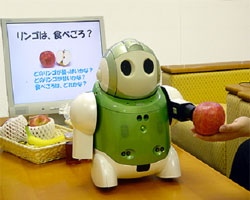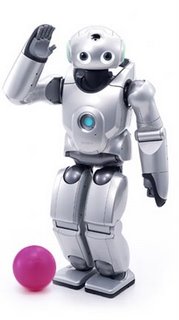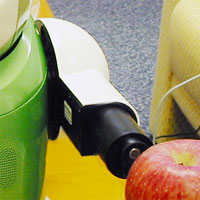NEC's Health and Food Advice Robot
u0303819
Ang Yong Chee
Health and Food Advice Robot
While most of the media attention goes to high publicized domestic robots like the Sony’s QRIO and the Mitsubishi’s Wakamuru , another Japanese giant NEC has announced that it has developed a new robot that is capable of tasting food .


 Above NEC's Health and Food advice robot , Sony's QIRO , Mitsubishi's Wakamura (from left )
This robot with “taste buds” is a new feature added to the common existing ones like patrolling the home with built-in cameras for detecting intrusion , recognizing faces and voices to communicate with its owners as well as to provide information and controlling home appliances .
Officially called the “ Health and Food Advice Robot “ and dubbed as the world’s first partner robot with a sense of taste by its creator, NEC System Technologies . The robot is able to analyze the food and ingredients and also to perform food tasting . In other words , the robot is able to break down the compositions of the food and also differentiate among the variants of a particular food . For example, the robot is able to determine the amount of fat composition in a cheese and possibly what kind (brand) of cheese it is .
On top of it , the robot can also offer advices to its user if it is given its user’s health profile . The advices include how to improve the user’s health and eating habits based on the robot’s analysis of the user’s diet .
Technology behind the “food tasting”
The robot has an infrared sensor equipped to one of its arms . This robot utilizes a property called “ spectrum reflection ratio” to determine the composition of the food . Varying wavelengths of infrared light are beamed onto the food, where the spectrums of the reflected infrared lights are analyzed to determine the actual contents in the food.
Above NEC's Health and Food advice robot , Sony's QIRO , Mitsubishi's Wakamura (from left )
This robot with “taste buds” is a new feature added to the common existing ones like patrolling the home with built-in cameras for detecting intrusion , recognizing faces and voices to communicate with its owners as well as to provide information and controlling home appliances .
Officially called the “ Health and Food Advice Robot “ and dubbed as the world’s first partner robot with a sense of taste by its creator, NEC System Technologies . The robot is able to analyze the food and ingredients and also to perform food tasting . In other words , the robot is able to break down the compositions of the food and also differentiate among the variants of a particular food . For example, the robot is able to determine the amount of fat composition in a cheese and possibly what kind (brand) of cheese it is .
On top of it , the robot can also offer advices to its user if it is given its user’s health profile . The advices include how to improve the user’s health and eating habits based on the robot’s analysis of the user’s diet .
Technology behind the “food tasting”
The robot has an infrared sensor equipped to one of its arms . This robot utilizes a property called “ spectrum reflection ratio” to determine the composition of the food . Varying wavelengths of infrared light are beamed onto the food, where the spectrums of the reflected infrared lights are analyzed to determine the actual contents in the food.
 Now the food compositions in term of water, protein and other molecule types have been determined by the infrared sensor. Given the robot’s database of the food compositions, the robot is able to identify the food if it exists in its database or “remembers” it if it isn’t.
( picture left shows the infrared sensor on its arm )
References : http://www.necst.co.jp/english/press/20050609/index.htm
http://www.roboticsdaily.com/headline/Health-Food-Advice-Robot.html
Photo sources from :
NEC : http://plusd.itmedia.co.jp/lifestyle/articles/0506/09/news070.html
Mitsubishi Wakamaru : http://www.mhi.co.jp/kobe/wakamaru/english/about/index.html
Sony QIRO : http://www.sony.net/SonyInfo/QRIO/top_nf.html
Now the food compositions in term of water, protein and other molecule types have been determined by the infrared sensor. Given the robot’s database of the food compositions, the robot is able to identify the food if it exists in its database or “remembers” it if it isn’t.
( picture left shows the infrared sensor on its arm )
References : http://www.necst.co.jp/english/press/20050609/index.htm
http://www.roboticsdaily.com/headline/Health-Food-Advice-Robot.html
Photo sources from :
NEC : http://plusd.itmedia.co.jp/lifestyle/articles/0506/09/news070.html
Mitsubishi Wakamaru : http://www.mhi.co.jp/kobe/wakamaru/english/about/index.html
Sony QIRO : http://www.sony.net/SonyInfo/QRIO/top_nf.html


 Above NEC's Health and Food advice robot , Sony's QIRO , Mitsubishi's Wakamura (from left )
This robot with “taste buds” is a new feature added to the common existing ones like patrolling the home with built-in cameras for detecting intrusion , recognizing faces and voices to communicate with its owners as well as to provide information and controlling home appliances .
Officially called the “ Health and Food Advice Robot “ and dubbed as the world’s first partner robot with a sense of taste by its creator, NEC System Technologies . The robot is able to analyze the food and ingredients and also to perform food tasting . In other words , the robot is able to break down the compositions of the food and also differentiate among the variants of a particular food . For example, the robot is able to determine the amount of fat composition in a cheese and possibly what kind (brand) of cheese it is .
On top of it , the robot can also offer advices to its user if it is given its user’s health profile . The advices include how to improve the user’s health and eating habits based on the robot’s analysis of the user’s diet .
Technology behind the “food tasting”
The robot has an infrared sensor equipped to one of its arms . This robot utilizes a property called “ spectrum reflection ratio” to determine the composition of the food . Varying wavelengths of infrared light are beamed onto the food, where the spectrums of the reflected infrared lights are analyzed to determine the actual contents in the food.
Above NEC's Health and Food advice robot , Sony's QIRO , Mitsubishi's Wakamura (from left )
This robot with “taste buds” is a new feature added to the common existing ones like patrolling the home with built-in cameras for detecting intrusion , recognizing faces and voices to communicate with its owners as well as to provide information and controlling home appliances .
Officially called the “ Health and Food Advice Robot “ and dubbed as the world’s first partner robot with a sense of taste by its creator, NEC System Technologies . The robot is able to analyze the food and ingredients and also to perform food tasting . In other words , the robot is able to break down the compositions of the food and also differentiate among the variants of a particular food . For example, the robot is able to determine the amount of fat composition in a cheese and possibly what kind (brand) of cheese it is .
On top of it , the robot can also offer advices to its user if it is given its user’s health profile . The advices include how to improve the user’s health and eating habits based on the robot’s analysis of the user’s diet .
Technology behind the “food tasting”
The robot has an infrared sensor equipped to one of its arms . This robot utilizes a property called “ spectrum reflection ratio” to determine the composition of the food . Varying wavelengths of infrared light are beamed onto the food, where the spectrums of the reflected infrared lights are analyzed to determine the actual contents in the food.
 Now the food compositions in term of water, protein and other molecule types have been determined by the infrared sensor. Given the robot’s database of the food compositions, the robot is able to identify the food if it exists in its database or “remembers” it if it isn’t.
( picture left shows the infrared sensor on its arm )
References : http://www.necst.co.jp/english/press/20050609/index.htm
http://www.roboticsdaily.com/headline/Health-Food-Advice-Robot.html
Photo sources from :
NEC : http://plusd.itmedia.co.jp/lifestyle/articles/0506/09/news070.html
Mitsubishi Wakamaru : http://www.mhi.co.jp/kobe/wakamaru/english/about/index.html
Sony QIRO : http://www.sony.net/SonyInfo/QRIO/top_nf.html
Now the food compositions in term of water, protein and other molecule types have been determined by the infrared sensor. Given the robot’s database of the food compositions, the robot is able to identify the food if it exists in its database or “remembers” it if it isn’t.
( picture left shows the infrared sensor on its arm )
References : http://www.necst.co.jp/english/press/20050609/index.htm
http://www.roboticsdaily.com/headline/Health-Food-Advice-Robot.html
Photo sources from :
NEC : http://plusd.itmedia.co.jp/lifestyle/articles/0506/09/news070.html
Mitsubishi Wakamaru : http://www.mhi.co.jp/kobe/wakamaru/english/about/index.html
Sony QIRO : http://www.sony.net/SonyInfo/QRIO/top_nf.html
11 comments:
U0308030 PHUNG DUC KIEN
Oa, amazing. I doubt that the robot can test many kinds of food. Simply because there is a lot of chemistry composition in a food product. Also, can the robot differentiate between a ripe apple and an unripe one ?
u0204714 Chan Hongjiang
A robot that can "taste" is indeed interesting. However, I don't really see the usefulness of such a robot. Perhaps it would be more useful if it can detect poisonous content in food. This way, it can be used to test food for VIPs in case someone decides to poison them.
eng10822 Loh Khai Choon
I also feel that there are still many parts that can be improved to the robot before it will become more appealing to the public. For example, would it be capable of differentiating if its an apple pie, or maybe say pineapple pie? Because the outer crust is the same, and would it be able to detect what is beneath it? I think that, since the technology is already there, this will be possible in the future, but like Phung said, there's too many composition inside a food product.
U037110X ZHAI NING
I think it is a matter of time that we can build a robotic which have all the senses of human being. But one thing i wonder how can we really make the robotic to analyze the composition of the food using chemical way, which is more accurate, or the function is jus t for fun?
Good try anyway, hope new robotic technology continuously amaze us.
u0205044 Yan Meixian
I guess the idea of introducing such a robot is more for health purpose rather than for taste right? Maybe it can be used for those who are very health-conscious and want to make sure the salt or fat or sugar content within the food is in an acceptable range before eating it. The idea of feeding a robot food before eating it sounds funny. Then you'll always get to eat a lesser mouthful.
To make the robot identify more food, maybe it can be made more user friendly. As in, after feeding a new type of food to the robot, you can record the name of this food to the robot so as to identify it the next time.
By the way, how does the food that the robot eat gets out of its body? Does this machine entails constant cleaning?
u0205183 Teo Yinling
I am also as curious as Meixian as to how they food eaten gets out of the robot? Does the person have to empty it like we empty our wastepaper basket?
U0307654 Lian Weiwen, Mervyn
To Yinling and Meixian:
I think that this robot does not physically eat the food. It just uses infrared light to determine the composition of the food, so no physical "eating" is involved.
Like what Hongjiang said, I was also hoping that it would be able to determine if food is poisoned. In addition, I am also wondering if it can detect bacteria, like detect if the food, which may contain mussells or oysters are thoroughly cooked and do they still have leftover bacteria which are still alive and are capable of causing Hepatitis B.
On the other hand, I also wonder if it can really accurately detect the composition of food. If that is the case, I think that no recipe is safe in the world! Perhaps the order in which you add the ingredients matter, then there may be some hope for chefs to protect their creative recipes.
From what I read and interpret, this robot does not really constitute what I would consider as tasting. In my opinion, the robot would have to be able to give an output like, "The food is salty or sweet to constitute tasting." However, such a condition would vary from one person to another because such interpretation of taste is subjective. It varies from one person to another. Maybe its owner can train the robot to learn what its owner considers as sweet or salty. Perhaps the "acme of perfection" would be a state where the robot, when fully trained, can tell its owner after tasting the food, whether the food is delicious or not! However, this may not be physically possible because this would be to replicate the brain's response to food. But I may be wrong. The world of robotics is interesting indeed!
U0204951 Xu Lixia
In my view,i seriously think that,there is not much need for such robots in fact.This is because by human beings,i am sure we could taste the good or badness of food.If one really need to know the composition of food,he might as well see from the ingredients stated in the food package.And what happens if the robot malfunction?The food that the robot says that is poisonous or something maybe actually be a delicious and healthy food.By then,wouldnt the person miss out a great delicacy?And by that time,wouldn't it need a human being to go and test if the robot has analysed correctly? Thus in such a case,human beings are still needed to test out the food themselves.So i was wondering is there really such a need for such kinds of robots.
U0308279 Chan Hwa Huei
Taste is very subjective, and it is hard to "program" a robot to tell its owner what the food taste like. However, its ability to determine the composition of food is useful to health-concious people and also to people who have allergies to certain food. Then again, from the photograph attached, we could see that the robot is much larger than the size of the apple next to it. Thus it will not be convenient to bring it along, when one dines out. And if one is preparing his own food at home, he would already know what type of ingredients is added. Thus the robot is not of much practical use. Hopefully, NEC can work on building a smaller model.
Post a Comment